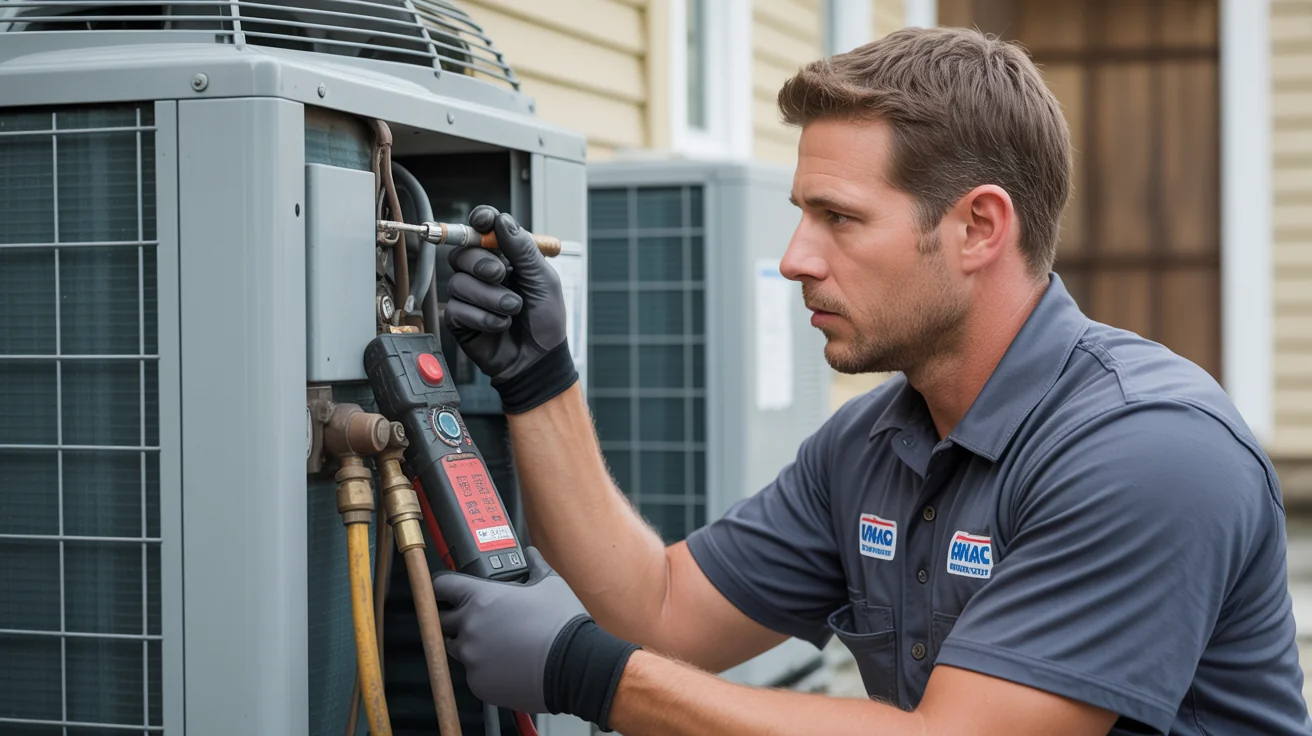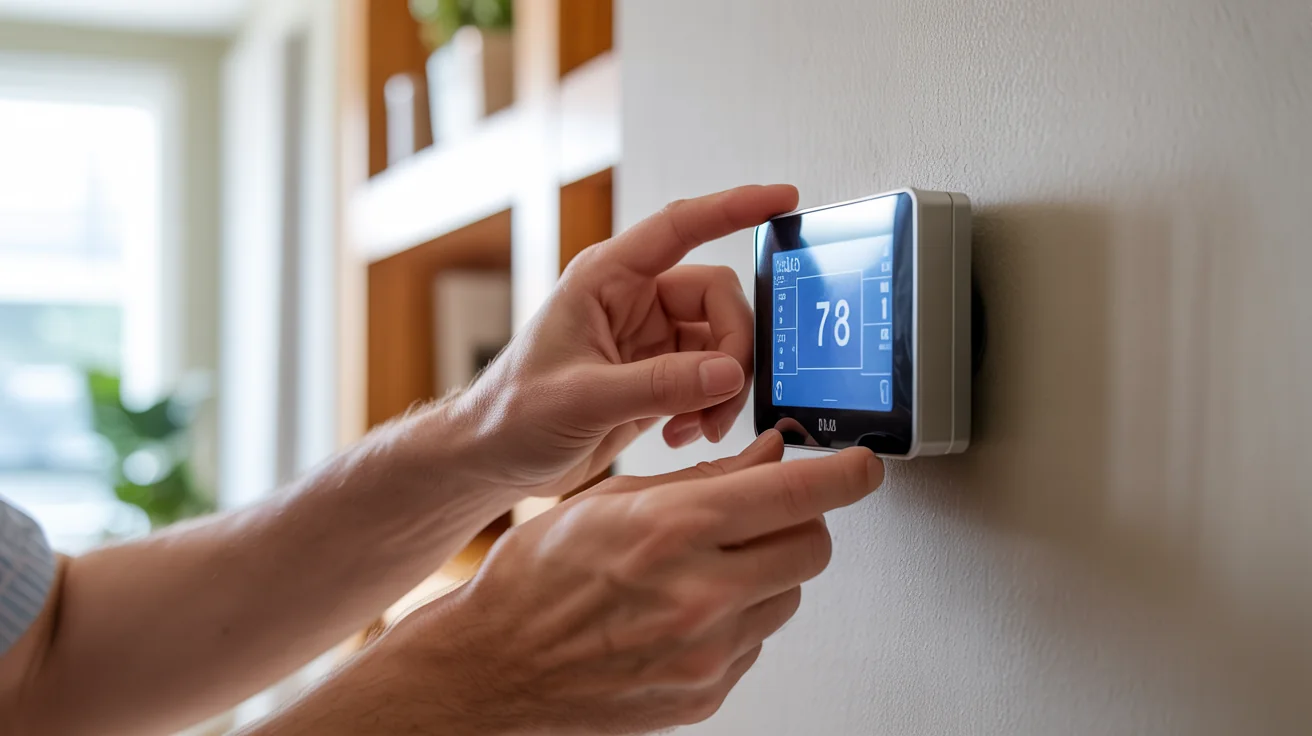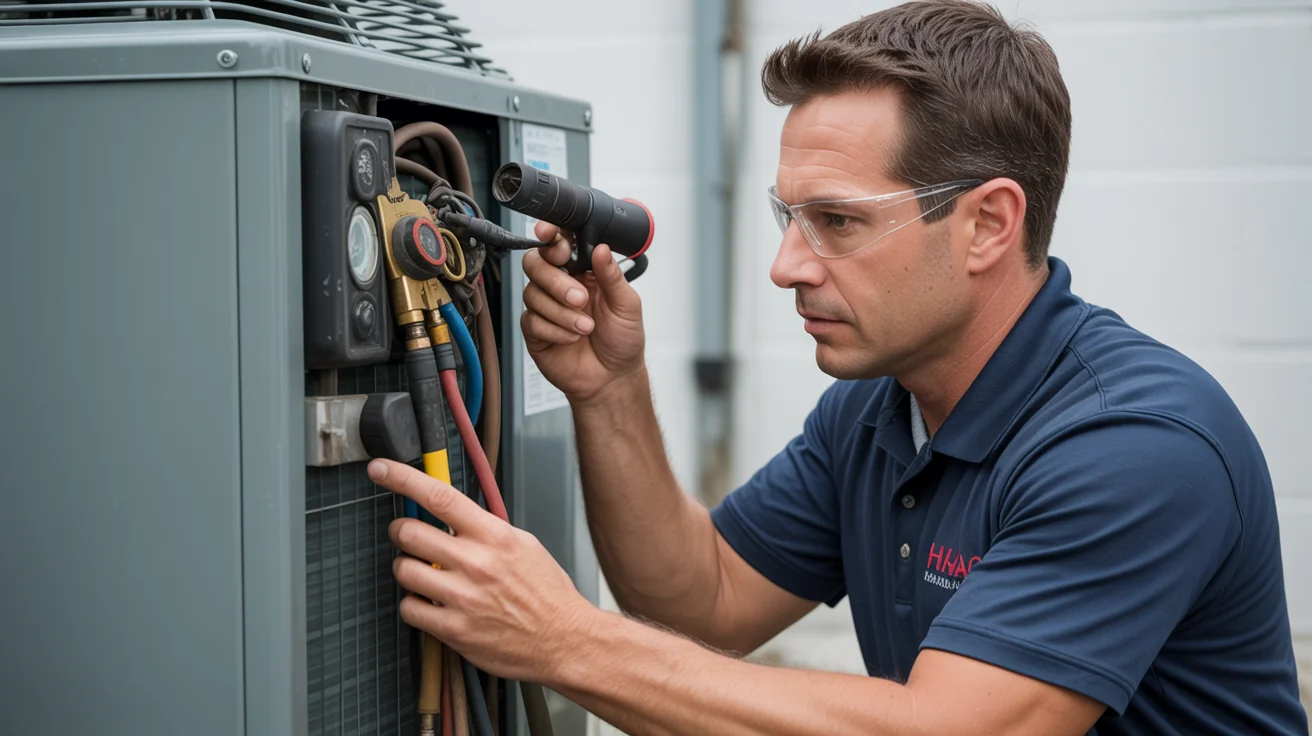Troubleshooting HVAC Electrical Problems Safety Guide (2025): Professional Diagnostics & Emergency Procedures
Complete HVAC electrical troubleshooting safety guide for North Texas homeowners. Diagnostic procedures, safety protocols, and when to call professionals.

Essential HVAC Electrical Safety for North Texas Homes
Here’s what 89% of North Texas homeowners don’t realize: HVAC electrical problems cause over 13,000 house fires annually and $4,500+ in damage when improperly diagnosed or ignored, yet most electrical issues can be safely identified and many resolved with proper knowledge and safety procedures.
This complete safety guide empowers you to safely diagnose electrical problems while knowing exactly when to stop and call professionals, preventing dangerous mistakes that risk your family’s safety and your home’s security.
Why HVAC Electrical Safety Is Critical in North Texas
Last month, I got called to a house fire in Plano that started because a homeowner tried to “fix” a buzzing contactor by hitting it with a screwdriver while the power was on. The arc flash not only burned him badly but ignited insulation in the outdoor unit, causing $45,000 in damage. That story could have had a much worse ending.
The Electrical Reality That Scares Me
After fifteen years working with HVAC electrical systems in North Texas, I’ve seen things that would make your hair stand up. Our extreme climate creates electrical problems that don’t exist in mild regions. When your AC system draws 30-45 amps for months straight in 105-degree heat, electrical connections get stressed in ways that cause failures most homeowners never anticipate.
Temperature extremes accelerate electrical component degradation at rates that shock even experienced technicians. I’ve pulled apart outdoor units where heat destroyed wire insulation, causing shorts that could have killed someone. The constant thermal cycling from Texas weather causes connections to work loose, creating resistance that generates heat and eventually fire.
Storm damage in North Texas is legendary among HVAC technicians. I’ve responded to lightning strikes that didn’t just damage HVAC systems - they turned control boards into molten plastic and sent voltage spikes through house wiring that destroyed electronics throughout the home. Power surges during our frequent thunderstorms fry expensive electronic components faster than homeowners can replace them.
The DIY Danger Zone
Here’s what keeps me up at night - the number of homeowners who think electrical work is simple because “it’s just wires.” I’ve been called to fix DIY electrical work that was so dangerous the fire marshal should have condemned the house. One homeowner in McKinney bypassed safety controls because they “kept tripping.” Those controls were preventing carbon monoxide poisoning, but he didn’t understand that.
CRITICAL SAFETY WARNING: NEVER work on live electrical circuits. I can’t emphasize this enough - electricity in HVAC systems can kill you instantly. Always turn off power at the breaker and verify it’s off with proper testing equipment. When in doubt, call professionals immediately. Your family’s safety is worth more than any repair bill.
HVAC Electrical System Overview
Understanding HVAC Electrical Components
High-Voltage Components (240V): Main disconnect serves as primary power shutoff for outdoor unit. Compressor draws 15-30 amps during operation. Condenser fan motor typically uses 3-8 amps. Electric heat strips consume 15-25 amps per element (if equipped). Heat pump backup heat requires high amperage auxiliary heating.
Low-Voltage Components (24V): Thermostat wiring uses 18-24 gauge control wiring. Control circuits include safety switches, relays, and contactors. Ignition systems handle gas furnace ignition and flame sensing. Sensors monitor temperature, pressure, and safety conditions.
Control Components: Contactors provide high-voltage switching controlled by low voltage. Relays handle low-voltage switching for various functions. Capacitors serve as motor starting and running components. Transformers step down voltage from 240V to 24V.
Common Electrical Problems
High-Voltage Issues: Tripped breakers occur from overload, short circuit, or ground fault protection activation during system stress. Burned contactors develop pitted contacts from arcing and wear, causing intermittent or failed operation. Failed capacitors prevent proper motor starting and running, leading to compressor and fan motor problems. Wiring deterioration from heat, age, and corrosion causes connection failures and safety hazards.
Low-Voltage Problems: Thermostat malfunctions create control signal failures that prevent proper system operation. Transformer failures eliminate low-voltage power to controls, shutting down the entire system. Wiring shorts in damaged control wiring cause intermittent malfunctions and unpredictable operation. Sensor failures affect temperature, pressure, or safety sensors that control system operation and protection.
Safe Electrical Troubleshooting Procedures
Related: Troubleshooting
Essential Safety Equipment
Required Safety Tools: Non-contact voltage testers detect live circuits without physical contact, providing essential safety verification. Digital multimeters measure voltage, current, and resistance safely when used with proper procedures. Insulated tools including screwdrivers and pliers with insulated handles protect against accidental electrical contact. Flashlights or headlamps illuminate work areas safely without creating shadows that hide hazards. Safety glasses provide essential eye protection from arc flash and flying debris.
Personal Safety Equipment: Rubber-soled shoes provide electrical insulation from ground, reducing electrocution risk during work. Keep hands and clothing dry, as moisture dramatically increases electrocution risk around electrical equipment. Remove all jewelry because metal jewelry conducts electricity and can cause severe burns or electrocution. Maintain work alone awareness by having someone nearby who can call for help in case of emergency.
Step-by-Step Safety Protocol
Pre-Troubleshooting Safety Checks:
- Turn off power: Switch off breaker at electrical panel
- Verify power off: Use non-contact voltage tester at disconnect
- Test your tester: Verify voltage tester works on known live circuit
- Lock out power: Place tape over breaker to prevent accidental energizing
- Wait 5 minutes: Allow capacitors to discharge safely
Safe Diagnostic Approach:
- Visual inspection first: Look for obvious damage before touching anything
- Smell for burning: Burned insulation has distinctive acrid odor
- Listen for sounds: Arcing, buzzing, or crackling indicates problems
- Check connections: Look for loose, corroded, or burned connections
- Document findings: Take photos of problems before making changes
What Homeowners Can Safely Check
Safe Visual Inspections: Check breaker position to determine if HVAC breakers have tripped during recent operation. Verify the outdoor unit disconnect switch is in the ON position for proper power supply. Examine thermostat display for blank screens or error codes that indicate control problems. Look at visible wiring for damaged, burned, or loose wires that create safety hazards. Assess component condition by checking for obvious damage or burn marks on electrical components.
Simple Electrical Tests (Power OFF Only): Continuity testing allows you to test fuses and simple circuits safely with power completely OFF. Resistance measurements help check heating elements and motors for proper operation with power OFF. Wire identification uses continuity testing to trace wiring paths and verify proper routing. Connection verification ensures proper wire connections and identifies loose or corroded connections.
Common HVAC Electrical Problems
Tripped Breakers and Electrical Overloads
Why Breakers Trip: Overload conditions occur when the system draws more current than the breaker rating during heavy operation. Short circuits happen when hot wires touch neutral or ground wires, creating dangerous current flow. Ground faults develop when current leaks to ground through damaged insulation, creating shock hazards. Arc faults occur when arcing connections trigger specialized arc fault breakers designed to prevent fires.
Safe Breaker Troubleshooting:
- Don’t immediately reset: Determine why breaker tripped
- Visual inspection: Check for obvious damage at electrical panel
- One reset attempt: If no obvious cause, try one reset
- Call professional: If breaker trips again, stop and call for service
When to Call Professional Immediately:
- Breaker trips repeatedly
- Burning smell from electrical panel
- Sparks or arcing at breaker
- Hot breaker handles
- Any signs of electrical damage
Capacitor Failures
Capacitor Function: Start capacitors: provide extra torque for motor starting. Run capacitors: improve motor efficiency during operation. Common failure: capacitors fail more frequently than motors.
Safe Capacitor Diagnosis:
- Power OFF required: Never test capacitors with power on
- Discharge first: Use insulated screwdriver to discharge (stored energy)
- Visual inspection: Look for bulged top, leaked oil, or burn marks
- Multimeter testing: Test capacitance with appropriate meter
- Professional replacement: High-voltage component requires professional service
Capacitor Safety Warnings: Stored energy: capacitors store dangerous electrical energy. Proper discharge: always discharge before handling. High voltage: even with power off, capacitors can shock. Professional service: capacitor replacement requires electrical expertise.
Contactor Problems
Contactor Function: High-voltage switching: controls power to compressor and fan motor. Low-voltage control: 24v coil controls high-voltage contacts. Common failure points: contacts burn, coils fail, mechanical wear.
Safe Contactor Inspection:
- Power OFF: Turn off breaker before inspection
- Visual examination: Look for burned, pitted, or welded contacts
- Contact alignment: Check for proper contact alignment
- Coil inspection: Look for burned or damaged control coils
- Professional evaluation: Complex diagnosis requires professional tools
Thermostat and Control Circuit Issues
Common Control Problems: Dead thermostat: no display, no response to settings. Erratic operation: system turns on/off unexpectedly. Temperature control: won’t maintain set temperature. Mode problems: heat/cool switching malfunctions.
Safe Thermostat Troubleshooting:
- Check batteries: Replace batteries in battery-powered units
- Verify settings: Ensure proper mode (heat/cool/auto) selection
- Temperature check: Compare thermostat reading to room temperature
- Wire inspection: Look for loose connections at thermostat (power OFF)
- Professional diagnosis: Complex control issues need professional service
When to Stop and Call Professionals
Immediate Professional Service Required
Dangerous Conditions: Sparks or arcing: any visible electrical arcing. Burning smell: electrical burning odor. Hot components: abnormally hot electrical components. Electrical shock: any shock sensation from equipment. Smoke: any smoke from electrical components.
Complex Problems: Repeated failures: same problem occurs repeatedly. Multiple symptoms: several electrical issues simultaneously. High-voltage work: any work involving 240v circuits. Control system problems: complex diagnostic needs. Safety system failures: gas furnace safety controls.
Professional Diagnostic Capabilities
Advanced Testing Equipment: Oscilloscopes: complex waveform analysis. Insulation resistance testers: high-voltage insulation testing. Power quality analyzers: electrical supply problem diagnosis. Thermal imaging: heat pattern analysis for problem identification. Combustible gas detectors: safety verification for gas appliances.
Professional Expertise: Electrical code compliance: ensure repairs meet safety codes. Load calculations: verify electrical capacity for equipment. Safety procedures: proper lockout/tagout and arc flash protection. Warranty preservation: professional repairs maintain equipment warranties. Comprehensive diagnosis: identify root causes, not just symptoms.
Emergency Electrical Procedures
Power Loss Emergency Response
Complete Power Loss:
- Check main breaker: Verify main electrical panel breaker position
- Check utility supply: Look for neighborhood outages
- Contact utility: Report outages to electrical provider
- Generator safety: Proper generator connection if available
- HVAC restart: Professional startup after extended outages
Partial Power Loss:
- Identify affected circuits: Determine which breakers are tripped
- Load assessment: Reduce electrical load before resetting breakers
- Professional evaluation: Partial power loss may indicate serious problems
- Equipment protection: Turn off HVAC until power stabilizes
Electrical Emergency Safety
Fire Prevention: Turn off power: at breaker if safely accessible. Evacuate if necessary: don’t risk safety for property. Fire department: call 911 for any electrical fires. Water danger: never use water on electrical fires. Class C extinguisher: only use appropriate fire extinguisher.
Electrocution Prevention: Never touch: don’t touch someone being electrocuted. Turn off power: shut off power at breaker if safely possible. Call 911: get emergency medical help immediately. Use wood/plastic: move person with non-runive material only. CPR training: learn cpr for electrical emergency response.
Professional Electrical Service
When Professional Service Is Required
High-Voltage Work: 240V circuits: all high-voltage electrical work. Panel modifications: electrical panel changes or additions. Circuit installation: new electrical circuits for hvac equipment. Code compliance: ensure all work meets electrical codes. Permit needs: most electrical work requires permits.
Complex Diagnostics: Intermittent problems: electrical issues that come and go. System integration: multiple system interaction problems. Control system programming: advanced thermostat and control setup. Performance optimization: electrical efficiency improvements. Safety verification: comprehensive safety system testing.
Jupitair’s Electrical Services
Emergency Electrical Response: 24/7 availability: emergency electrical service. Licensed electricians: state-licensed electrical contractors. Safety first: comprehensive safety procedures. Rapid diagnosis: advanced diagnostic equipment. Code compliance: all work meets or exceeds electrical codes.
Comprehensive Services: Electrical troubleshooting: complete system diagnosis. Component replacement: capacitors, contactors, controls. Wiring repair: damaged wiring restoration. Panel upgrades: electrical service improvements. Safety inspections: comprehensive electrical safety evaluation.
Cost Analysis of Electrical Problems
Typical Electrical Repair Costs
Related: Repair Costs
Common Component Replacement: Capacitors: $150-300 professional replacement. Contactors: $200-400 including installation. Transformers: $250-450 with professional installation. Thermostats: $200-600 depending on type and features. Wiring repair: $150-500 depending on complexity.
Professional Service Costs: Diagnostic service: $149-249 (usually credited toward repair). Emergency service: $250+ premium for after-hours calls. Complex diagnosis: $200-400 for difficult problems. Safety inspections: $150-300 for complete evaluation.
Cost of Ignoring Electrical Problems
Equipment Damage: Compressor failure: $2,500-4,500 from electrical problems. Blower motor damage: $800-1,500 from power quality issues. Control system damage: $500-2,000 from voltage problems. Complete system loss: $8,000+ from major electrical failures.
Safety and Property Risks: House fires: $50,000+ average fire damage. Insurance issues: coverage problems with diy electrical work. Personal injury: electrocution and burn treatment costs. Code violations: fines and required professional correction.
Preventing Electrical Problems
Maintenance Prevention
Regular Electrical Maintenance: Annual inspection: professional electrical system evaluation. Connection tightening: prevent loose connection problems. Component testing: identify failing components before failure. Power quality monitoring: detect electrical supply problems. Surge protection: protect against power surges and lightning.
Environmental Protection: Weather sealing: protect outdoor electrical connections. Rodent prevention: prevent wire damage from pests. Vegetation management: keep plants away from electrical equipment. Drainage: prevent water intrusion into electrical components.
Long-Term Electrical Health
System Upgrades: Panel modernization: replace outdated electrical panels. Circuit capacity: ensure adequate electrical capacity. GFCI protection: ground fault protection for safety. Surge protection: whole-house surge protection systems. Professional installation: use licensed contractors for all work.
Frequently Asked Questions
Q: Can I reset a tripped breaker safely? A: Yes, but only once. If the breaker trips again, call a professional. Never repeatedly reset tripping breakers as this indicates a serious problem.
Q: Why does my AC breaker keep tripping? A: Common causes include dirty coils, failed capacitors, compressor problems, or electrical faults. Professional diagnosis is required for repeated tripping.
Q: Is it safe to use extension cords for HVAC equipment? A: No, HVAC equipment should never be powered by extension cords. This creates fire and safety hazards and violates electrical codes.
Q: How can I tell if my electrical problem is serious? A: Call professionals immediately for: burning smells, sparks, repeated breaker trips, hot electrical components, or any shock sensation.
Q: What should I do if my thermostat stops working? A: Check batteries first, then check breaker and fuse. If these don’t solve the problem, call for professional diagnosis.
Q: Can power surges damage my HVAC system? A: Yes, power surges can damage compressors, motors, and control systems. Surge protection is important for equipment protection.
Your Electrical Safety Action Plan
Immediate Safety Assessment
- Safety inspection: Visual check of electrical components and connections
- Testing equipment: Acquire basic electrical testing tools
- Emergency procedures: Establish electrical emergency response plan
- Professional contact: Identify qualified electrical contractors
Long-Term Electrical Health
- Maintenance schedule: Annual professional electrical inspection
- Upgrade planning: Consider electrical system improvements
- Safety training: Learn basic electrical safety procedures
- Documentation: Keep records of electrical work and problems
Get Professional Electrical Service
Don’t risk your safety or your home with electrical problems. Jupitair’s licensed electrical contractors provide safe, professional diagnosis and repair of all HVAC electrical issues.
Need electrical help now? Call (940) 390-5676 for 24/7 emergency electrical service from experienced HVAC electrical specialists. Our licensed electricians have specialized HVAC training to handle complex electrical problems safely. We maintain safety first protocols with complete safety procedures to protect your family and property. Our rapid response team provides immediate service for electrical emergencies throughout North Texas.
Protect your family and your home. Our licensed professionals make sure safe, code-compliant electrical service that keeps your HVAC system operating reliably and safely.
Licensed Electrical Contractors | HVAC Electrical Specialists | Serving North Texas since 2008
Jupitair HVAC: Licensed & Insured electrical contractors providing safe HVAC electrical services across Plano, Frisco, McKinney, Allen, The Colony, Little Elm, and surrounding North Texas communities.
Need Professional HVAC Service?
Our certified technicians are ready to help with any HVAC needs in North Texas




